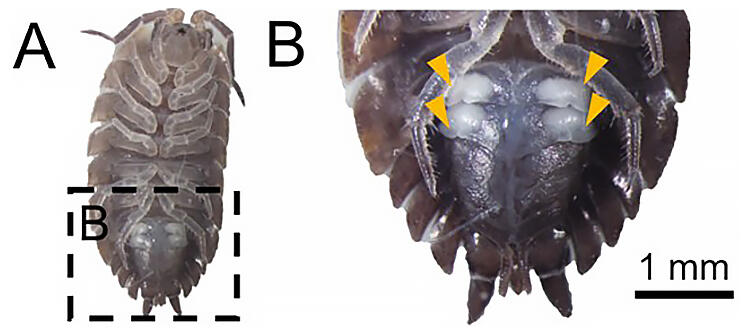Terrestrial isopods, such as woodlice, are a specific group among crustaceans that emerged onto the land and diversified. Many species in this group have air-breathing organs in their abdomens known as lungs or "pseudotrachea". The presence of lungs is an important trait, and was the key to the emergence of isopods onto land and their diversification there, but it was not known how and when these form in the course of their development.
A group centered on Professor Toru Miura and graduate student Naoto Inui of the Misaki Marine Biological Station, School of Science, the University of Tokyo, has clarified, for the first time, the process through which these lungs form via detailed morphological and histological observations of woodlice (Porcellio scaber), a species that is easily collected from around human homes. Their outcomes were published in Arthropod Structure & Development.

Provided by the University of Tokyo
Specifically, the group used a scanning electron microscope, confocal laser microscope and tissue sections to observe the shape of the pleopods (abdominal limbs) where the lungs form from the period after embryogenesis to the juvenile period after hatching. Consequently, they saw that lung formation occurs in the juvenile period after hatching, that the second of the two pairs of lungs forms immediately after hatching while the first pair forms in the juvenile period after this, and that inside the pleopods where the lungs form, epithelial invagination occurs before shedding, and a new cuticle layer forms.
From these outcomes, it is estimated that during the process of their emergence onto land, terrestrial isopods such as woodlice gained a new development pathway that causes this pleopodal epithelial invagination. From now on, the group will focus on clarifying the molecular mechanism of lung formation based on the knowledge of formation process gained during this study. It is hoped that this will deepen researchers' understanding of the evolution of organs for air respiration in animals and the mechanism by which they emerged onto land.
Journal Information
Publication: Arthropod Structure & Development
Title: Pleopodal lung development in a terrestrial isopod, Porcellio scaber (Oniscidea)
DOI: 10.1016/j.asd.2022.101210
This article has been translated by JST with permission from The Science News Ltd.(https://sci-news.co.jp/). Unauthorized reproduction of the article and photographs is prohibited.




